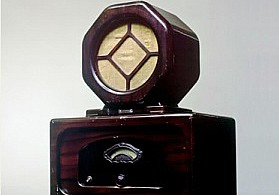 Panasonic Corporation is one of the largest electronic product manufacturers in the world, comprised of over 634 companies. The Japanese company began when Konosuke Matsushita founded Matsushita Electric Housewares Manufacturing Works in 1918. The foundation of the company is to devote itself to the “progress and development of society and the well-being of all people around the globe.” In looking at the company’s history, it is really a window into the growth of the consumer appliance and electronics markets over the past 90 years.
Panasonic Corporation is one of the largest electronic product manufacturers in the world, comprised of over 634 companies. The Japanese company began when Konosuke Matsushita founded Matsushita Electric Housewares Manufacturing Works in 1918. The foundation of the company is to devote itself to the “progress and development of society and the well-being of all people around the globe.” In looking at the company’s history, it is really a window into the growth of the consumer appliance and electronics markets over the past 90 years.
 In the early 1920s the company made its manufacturing debut with bicycle headlamps. In 1927, the company moved into electro-thermal products, including irons and “feet warmers.” In the 1930s, it started in radio production, developing its first radio in 1931. The company set up an electric motor department in 1933. Matsushita stated at the time that, "the quality of life of the average family is destined to improve, and a day will come when most homes use at least 10 electric motors. The demand for motors will be unlimited." In the mid-1930s the company began production of dry cell batteries and the next year started production of light bulbs.
In the early 1920s the company made its manufacturing debut with bicycle headlamps. In 1927, the company moved into electro-thermal products, including irons and “feet warmers.” In the 1930s, it started in radio production, developing its first radio in 1931. The company set up an electric motor department in 1933. Matsushita stated at the time that, "the quality of life of the average family is destined to improve, and a day will come when most homes use at least 10 electric motors. The demand for motors will be unlimited." In the mid-1930s the company began production of dry cell batteries and the next year started production of light bulbs.
World War II disrupted the company’s productions and left many of its factories destroyed. However, with the household appliance boom after World War II, Panasonic began to rebound and Matsushita's prediction was quickly being realized. In the 1950s, Panasonic continued its ventures into the household electronics market, branching into washing machines, televisions, and refrigerators. In 1959, the Matsushita Electric Corporation of America (MECA) was established in New York. The 1960s saw the company venturing into production of console stereos and speakers, fully automatic washing machines, console TVs and color televisions, air conditioners, microwave ovens, cassette recorders, and the consumer VCR.
The consumer electronics movement continued to grow around the world through the 1970s and into the 1980s. By 1983, Panasonic had already produced 10 million VCRs and its Video Division accounted for a large proportion of the company's sales. The company’s VHS system gradually cornered the divided video market at the time and by 1987 had become the worldwide standard. The 1980s saw continued advancements in audio, video, and electronics technologies, including mobile phones. In the 1990s Panasonic played a pivotal role in the development of digital television systems and became a leader in the plasma display panel technology by 2005. Less than 10 years later, Panasonic is now in the forefront of bringing 4K resolution products and technologies to the market including 4K Ultra HD TV
In addition to its consumer products, Panasonic’s business and industrial products are found throughout the globe and every corner of our daily lives. For example, rapid growth in electric and hybrid vehicles have in part been made possible by Panasonic, now the global leader in production of EV batteries. In fact, Panasonic’s advanced battery technologies power Tesla’s all-electric vehicles and the world’s best-selling hybrid vehicle, the Toyota Prius. Panasonic also is a global leader in the development of energy storage batteries and systems for both residential and commercial applications.
Environmental Commitment
Panasonic made an impact in corporate environmental responsibility in the early 1990s with its "Environmental Charter." The charter called for the adoption of the latest environmentally-friendly technologies and processes to be applied in all of the company’s operating units.
the early 1990s with its "Environmental Charter." The charter called for the adoption of the latest environmentally-friendly technologies and processes to be applied in all of the company’s operating units.
In 2007, Panasonic Corporation announced its “Eco Ideas Declaration,” as a commitment to the acceleration of environmental management, especially in addressing global climate change. The company is pursuing advanced environmental strategies based upon three “eco ideals,” including reducing its global carbon footprint, increasing the number of energy-efficient products it manufactures and encouraging the growth of environmental awareness and sustainability worldwide.
Panasonic Corporation of North America is a strong proponent of the responsible recycling of electronics. Panasonic, together with Sharp Electronics Corporation and Toshiba America Consumer Products, established the Manufacturers Recycling Management Company, LLC (MRM). MRM is an EPA-award winning venture which manages collection and recycling operations.
Panasonic recently became NERC’s second Benefactor Advisory Member. Remarked Panasonic’s Director of the Corporate Environmental Department, “our company has been actively involved in NERC’s electronics projects for a number of years, including as a Sponsor of the State Electronics Challenge, and through MRM’s Advisory Membership. We are honored to provide increased support to advance NERC’s environmental work by becoming a Benefactor.”

